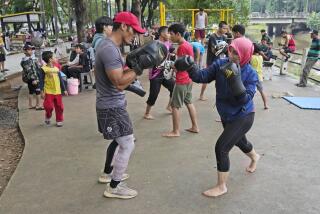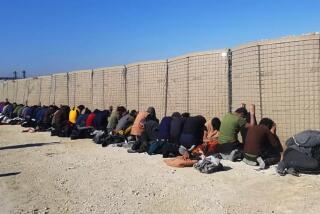Female attackers are still few among Islamic extremist groups
Reporting from JOHANNESBURG, South Africa — She is popularly known as “the White Widow,” but the truth about the blue-eyed jihadist suspected of orchestrating the deaths of hundreds of people across Africa is as shadowy as the cloaked world of international terrorism she inhabits.
No one is quite certain of the whereabouts of Samantha Lewthwaite, a purported ringleader with the Somali militant group Shabab who is suspected in a string of grenade attacks, bombings and mass shootings in Kenya. Conventional wisdom has it that she put on 30 pounds and had plastic surgery to disguise her appearance. One theory is that she’s now in Syria with Islamic State insurgents, training suicide bombers. Another holds that she died in Ukraine, shot by a Russian sniper. Some say she is alive somewhere in Somalia, married to a warlord.
Lewthwaite, a British soldier’s daughter who converted to Islam as a teenager and later joined the terrorist underground, is one of the best-known of a growing cadre of operational women in the conservative and often patriarchal ranks of Islamic extremism. While significant numbers of women are believed to have flocked to Syria over the last two years to serve as home-base support for Islamic State, hardly any have been seen plotting and carrying out the grisly executions, shootings and bombings that have become the militant group’s expanding signature around the globe.
The White Widow, as she’s been dubbed by the British press, is an exception. So is San Bernardino killer Tashfeen Malik, who with her husband wielded a .223-caliber tactical rifle in the deadly Dec. 2 attack on a center that provides services for the disabled, killing 14 people, and then sprayed a hail of gunfire at pursuing police.
While women have a long history among violent militant organizations in Europe and Latin America — even in the Middle East, women have been an important part of the Kurdish rebellion in Turkey and northern Iraq — female attackers have been far more rare in such organizations as Al Qaeda, where women are normally encouraged to raise families and tend homes for male fighters.
Islamic State in recent years has established the all-female Al Khansaa brigade, and online propaganda glorified its role, featuring women clad from head to toe in black flowing garments and toting AK-47s. But the brigade’s role is merely to police other women’s veils and morals, ordering whippings for those whose face coverings are deemed too transparent.
But female operatives among Islamist groups are not unprecedented, terrorism analysts say, with examples of female suicide bombers dating back to the 1990s in the Russian republic of Chechnya, and in the Palestinian territories and northeastern Nigeria.
In some ways, terrorist groups may be looking to use women to their advantage because of the effect on Western “audiences,” said Emily Dyer, analyst with the London-based think tank the Henry Jackson Society. “There’s an added shock factor,” she said. “Terrorist attacks in the West are all about Islamic State propaganda and gaining as much media attention as possible.”
In the early days of Chechnya’s unsuccessful war for independence from Russia, women in the conservative Islamic region were so subservient they didn’t even eat at the same table as men. Yet there were dozens of female militants, who fought alongside men in rebel units, according to Mairbek Vatchagaev, analyst with the Jamestown Foundation. He said it was one of the few examples of Muslim women fighting beside men in war.
“It was their personal feeling in their soul that they must defend their homeland. But it wasn’t compulsory for women to fight. On the contrary,” Vatchagaev said. “The women in the first war (1994-96) didn’t talk about Islam. They talked about their patriotic duty to their homeland.”
The phenomenon of women taking up arms was unexpected in Chechnya’s conservative culture, and some women’s husbands divorced them for doing so.
In 1995, a group of Arab fighters steeped in conservative Islamist ideology, led by a rebel commander named Khattab, entered Chechnya and proclaimed it was a sin for women to fight. Still, they urged women to be suicide bombers, leading to the phenomenon of Chechen “black widows” who launched many suicide bombings in Russia.
“They taught them to blow themselves up and they told them it was good for Islam. The Arabs said if women blew themselves up, they’d go to heaven. But suicide bombings were totally alien to Chechens,” Vatchagaev said.
By 2002, when 41 Islamist attackers took 700 hostages at a theater in Moscow, 19 of the assailants were women.
Thousands of Chechens are now in Syria, many of whom had been living in Turkey, Egypt and Saudi Arabia when Islamic State declared it was forming a caliphate in the region and invited Muslims around the world to join. There are many Chechen women in Syria, but none are known to be in combat roles, Vatchagaev said.
In northwestern Nigeria, girls as young as 8 or 10 have often been used as suicide bombers by the group Boko Haram, but there are suspicions that their explosive vests may be detonated by other people.
There have been scattered lone-wolf attacks by females. On Tuesday, a Palestinian woman carrying a large, concealed screwdriver was arrested by Israeli security forces on suspicion of planning a stabbing attack in Jerusalem.
In 2010, British student Roshonara Choudhry stabbed a British member of Parliament in an attack said to be inspired by Al Qaeda. He survived and she is serving life imprisonment for attempted murder.
There is also the lurid story of “punk rocker granny” Sally Jones, designated a terrorist by the U.S., who traveled to Syria to marry convicted hacker Junaid Hussain. Hussain, a key figure in Islamic State because of his computer technology capabilities, was killed in a U.S. airstrike in August. Jones, who reportedly was formerly in a punk band, is a prominent Islamic State figure on social media.
Lewthwaite, whose whereabouts remains unknown, took the name Sherafiyah when she converted to Islam in her late teens. She is the widow of Germaine Lindsay, one of four suicide bombers who attacked three London subway cars and a bus in July 2005, killing 52 others. Having met Lindsay at an antiwar march in 2002, she fled England after his suicide attack. She went to Africa and later joined the Shabab.
The subject of many breathless British tabloid headlines, Lewthwaite is the best known among contemporary female extremists because of reports, never confirmed, that she planned the 2013 attack on the Westgate shopping mall in Nairobi, Kenya, which killed 67 people; and the attack this year on a university in Garissa, northeastern Kenya, which left 148 people dead.
Interpol, at Kenya’s request, in 2013 issued a red alert for the arrest of Lewthwaite on charges of possession of explosives and conspiracy to commit a felony in 2011.
Join the conversation on Facebook >>
Women play a vital social media role for Islamic State, extolling the virtues of life in the caliphate, laughing about Yazidi women slaves, or the time they saw their first body. Often, they act as cheerleaders for the brutal executions meted out by the group and attempt to groom young followers in the West, exhorting them to come to Syria.
Umm Layth, who has a popular Syria-based blog, answers questions from women who want to go to the country and urges them to do so. But she has told followers to forget any hope of fighting.
“I will be straight up and blunt with you all, there is absolutely nothing for sisters to participate in Qitaal [fighting],” she wrote. “These are all rumors you may have heard through some sources who themselves are not actually aware of the truth. And the women you may have seen online participating are all part of a propaganda. For the sisters it’s completely impossible for now.”
MORE ON SAN BERNARDINO
President Obama, first lady meet families of San Bernardino shooting victims
San Bernardino shooter’s friend Enrique Marquez accused of fraud in $200-per-month marriage
Marquez and Farook plotted campus and freeway attacks, prosecutors allege
More to Read
Sign up for Essential California
The most important California stories and recommendations in your inbox every morning.
You may occasionally receive promotional content from the Los Angeles Times.










